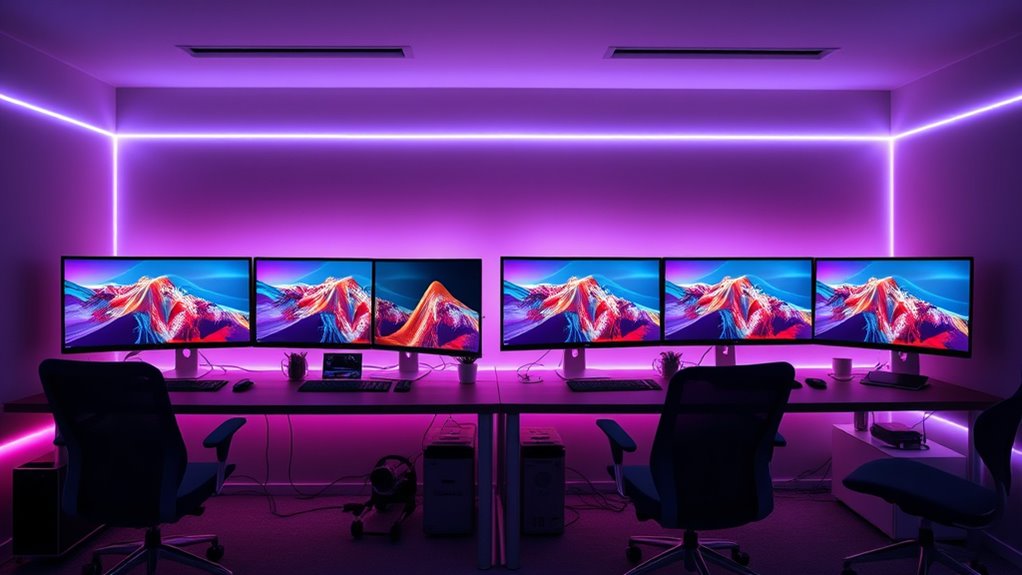If you’re looking for the best Mac Studios for 3D rendering in 2025, I recommend considering options like the Mac Studio with M4 Pro chips, offering up to 12-core CPUs and 16-core GPUs for demanding workflows. The compact size, high-performance hardware, and large memory options make them perfect for efficient rendering. To find out which models strike the right balance for your needs, keep exploring the key factors I’ve outlined.
Key Takeaways
- Prioritize Mac Studios with M4 Pro chips, 24GB RAM, and 512GB SSD for optimal 3D rendering performance.
- Ensure the device offers ample connectivity options like Thunderbolt 4, HDMI, and Ethernet for seamless workflow integration.
- Choose compact models with efficient cooling and ventilation to support long, demanding rendering sessions.
- Consider the device’s GPU core count and VRAM capacity for handling complex textures and high-resolution assets.
- Balance price and performance by selecting models with high processing power and expandability features suited for professional 3D work.
Apple Mac mini Desktop Computer with M4 Chip and 24GB Memory
If you’re looking for a compact yet powerful computer for 3D rendering, the Apple Mac mini with M4 chip and 24GB of memory is an excellent choice. Its small, five-by-five-inch design fits easily beside your monitor or in tight spaces, yet it packs impressive performance. The M4 chip, with a 10-core CPU and GPU, ensures smooth, fast rendering and multitasking. With 24GB of unified memory and a 512GB SSD, data access is quick, and workflows stay fluid. Plus, its versatile connectivity options, including Thunderbolt, HDMI, and USB-C, make it easy to connect peripherals, making the Mac mini a compact powerhouse for demanding creative work.
Best For: creative professionals and power users seeking a compact, high-performance computer for 3D rendering, multitasking, and demanding workflows.
Pros:
- Compact size fits easily in tight spaces and complements any workspace
- Powerful M4 chip with 10-core CPU and GPU delivers fast, smooth performance for rendering and multitasking
- 24GB unified memory and 512GB SSD ensure quick data access and responsive workflow
Cons:
- Limited upgrade options due to integrated design
- May be more expensive compared to traditional desktops with similar specs
- Lacks dedicated graphics card, which could impact high-end 3D rendering performance in some cases
Apple Mac mini Desktop Computer with M4 Chip (256GB SSD, 16GB RAM)
The Apple Mac mini with M4 chip is an excellent choice for anyone seeking a powerful, space-saving computer for 3D rendering, especially when working within a compact setup. Its five-by-five-inch design makes it easy to place next to monitors or in tight spaces, while still offering impressive performance thanks to the 10-core CPU and GPU. With 16GB of unified memory and a 256GB SSD, it handles demanding tasks smoothly and quickly. The versatile connectivity options—including Thunderbolt, HDMI, USB-C, and Ethernet—ensure seamless workflow. Built on Apple Silicon, it integrates well with the Apple ecosystem, boosting productivity and creative efficiency in a tiny but mighty package.
Best For: creative professionals and power users seeking a compact yet high-performance computer for 3D rendering, video editing, and demanding workflows.
Pros:
- Compact, space-saving design ideal for small workspaces
- Powerful M4 chip with 10-core CPU and GPU for fast, fluid performance
- Versatile connectivity options including Thunderbolt, HDMI, and Ethernet
Cons:
- Limited internal storage capacity at 256GB, which may require external drives for large projects
- No dedicated graphics card, potentially limiting performance in certain high-end 3D applications
- Upgradable components are not user-accessible, restricting future hardware enhancements
Apple 2024 Mac mini Desktop Computer with M4 Chip
The Apple 2024 Mac mini with M4 chip is an excellent choice for 3D rendering professionals who need a compact yet powerful machine. Its small 5×5-inch design fits easily next to any monitor, making it perfect for tight workspaces. Powered by the M4 chip with a 10-core CPU and GPU, it offers fast, fluid performance for demanding tasks. Equipped with 16GB of unified memory and a 512GB SSD, it handles large projects efficiently. Plus, its extensive connectivity options—including Thunderbolt, HDMI, and USB-C ports—ensure seamless workflow integration. Overall, it combines space-saving design with robust performance, making it ideal for professional 3D rendering.
Best For: professional 3D rendering artists and developers requiring a compact, high-performance desktop with seamless Apple ecosystem integration.
Pros:
- Compact 5×5-inch design fits easily into tight workspaces
- Powerful M4 chip with 10-core CPU and GPU delivers fast, fluid performance
- Extensive connectivity options including Thunderbolt, HDMI, and USB-C
Cons:
- Limited to 512GB SSD storage, which may require external drives for large projects
- No dedicated graphics card option, relying solely on integrated M4 GPU
- Higher price point compared to some traditional mini PCs or desktops
Apple 2024 Mac mini Desktop Computer with M4 Pro chip
Designed for demanding 3D rendering tasks, the Apple 2024 Mac mini with M4 Pro chip offers impressive power in a compact package. Its five-by-five-inch design fits easily next to monitors or in tight spaces, delivering large capabilities despite its small size. The M4 Pro’s 12-core CPU and 16-core GPU, combined with 24GB of unified memory and a 512GB SSD, handle complex scenes and large code compilations effortlessly. With diverse ports—including Thunderbolt, HDMI, Gigabit Ethernet, and USB-C—it guarantees seamless connectivity. Optimized for Apple Silicon, it runs macOS efficiently, integrating smoothly with the Apple ecosystem for enhanced productivity.
Best For: professionals and power users who need a compact yet highly capable desktop for demanding 3D rendering, large code compilations, and creative tasks within the Apple ecosystem.
Pros:
- Compact size fits easily into tight workspaces and next to monitors.
- Powerful M4 Pro chip with 12-core CPU and 16-core GPU for demanding workloads.
- Seamless integration with macOS and the Apple ecosystem enhances productivity and user experience.
Cons:
- Limited storage options starting at 512GB may require external solutions for large data needs.
- Higher price point compared to less powerful mini desktops.
- Limited upgradeability due to integrated hardware design.
Factors to Consider When Choosing a Mac Studio for 3D Rendering

When selecting a Mac Studio for 3D rendering, I consider several key factors to guarantee ideal performance. These include processing power, memory capacity, graphics performance, storage needs, and connectivity options. Focusing on these points helps me choose a setup that handles complex projects efficiently.
Processing Power Needs
Choosing the right Mac Studio for 3D rendering hinges heavily on processing power, especially regarding CPU and GPU performance. A high-core-count CPU, such as a 12-core or higher, can markedly cut down rendering times by handling multi-threaded tasks efficiently. Equally important is the GPU; models with a 16-core or higher GPU guarantee smooth handling of complex scenes and detailed textures. Additionally, having ample unified memory—ideally 32GB or more—allows for efficient processing of large models and textures without bottlenecks. Faster storage options, like SSDs with higher read/write speeds, also play a vital role in accessing large project files quickly during rendering. Overall, investing in robust processing power is essential to meet the demanding needs of modern 3D workflows.
Memory Capacity Importance
The amount of memory in a Mac Studio directly impacts how smoothly it runs complex 3D rendering tasks. More RAM allows me to multitask efficiently and handle large files without lag, which is essential for detailed textures, models, and scene data. When memory is insufficient, the system relies more on slower disk storage, which hampers performance and extends rendering times. For advanced projects, I recommend at least 16GB of RAM to maintain a seamless workflow. Adequate memory not only improves current productivity but also future-proofs the workstation, ensuring it can accommodate increasingly detailed projects and software updates down the line. Investing in sufficient memory is vital for maximizing efficiency and minimizing delays during intensive 3D rendering sessions.
Graphics Performance Factors
To achieve ideal 3D rendering performance on a Mac Studio, I need to pay close attention to its GPU architecture, core count, and VRAM capacity, as these factors directly influence how quickly and efficiently I can process complex scenes. A more advanced GPU architecture offers better hardware acceleration and software compatibility, boosting rendering speed. The core count determines how many tasks the GPU can handle simultaneously; more cores mean faster processing of textures, shading, and detailed models. VRAM capacity is essential for managing large textures and high-resolution assets without slowdown or crashes. Additionally, efficient thermal management ensures sustained performance during long rendering sessions. Balancing these factors helps me select a Mac Studio that delivers powerful, reliable performance for demanding 3D workflows.
Storage Requirements
Have you considered how much storage capacity you’ll need for your 3D rendering projects on a Mac Studio? Large files, textures, models, and high-resolution outputs demand ample space. I recommend opting for at least 512GB SSD or more to guarantee smooth workflows without constant data management. For complex projects, higher storage options can save time and reduce frustration. External Thunderbolt SSDs are also a smart choice—they expand your capacity and offer faster data transfer speeds, which is vital during intensive rendering tasks. Prioritizing fast read/write speeds in your storage setup helps minimize delays caused by data access bottlenecks. Ultimately, sufficient and efficient storage keeps your workflow seamless, letting you focus on creating without interruptions.
Connectivity Options
Choosing the right connectivity options on your Mac Studio can considerably impact your 3D rendering workflow. I recommend ensuring it has multiple Thunderbolt 4 ports for high-speed peripherals and external displays, which are essential for multitasking and detailed work. Check if it supports HDMI or DisplayPort to handle multiple monitors, boosting productivity during complex projects. USB-C ports are versatile, allowing connection to external storage, drawing tablets, or other creative tools. A Gigabit Ethernet port is vital for stable, high-bandwidth internet access, especially when using cloud rendering or transferring large files. Additionally, consider audio jacks or extra ports if you plan to integrate external audio equipment or specialized input devices. These connectivity options streamline your workflow and reduce bottlenecks during intensive 3D rendering tasks.
Compatibility With Software
Ever wondered if your preferred 3D rendering software runs smoothly on a Mac Studio? It’s imperative to ensure that your software, like Blender, Maya, or Cinema 4D, supports the latest macOS and Apple Silicon. Compatibility can markedly impact performance and stability, so double-check that your applications are optimized for Apple Silicon chips. GPU acceleration is essential for rendering speed, so verify that your software leverages the GPU effectively. Additionally, make sure all necessary plugins and add-ons are available for macOS and compatible with your version. Finally, consider whether your software can utilize multiple cores and large memory setups, which are critical for handling complex scenes efficiently. Ensuring software compatibility guarantees a seamless workflow and maximizes your Mac Studio’s potential.
Space and Size
Selecting a Mac Studio for 3D rendering requires careful consideration of its space and size to guarantee it fits seamlessly into your workspace. You’ll want to confirm the device’s dimensions comfortably fit your designated area, especially if space is limited. Take into account the overall footprint, including any peripherals or accessories needed for your workflow. It’s important to evaluate how the size aligns with your existing setup to maintain both ergonomic comfort and aesthetic balance. Adequate ventilation and airflow are essential, as a cramped or overly compact space can hinder cooling during intensive rendering tasks. Finally, plan for enough desk or shelf space to prevent clutter, ensuring your workspace remains organized and efficient.
Budget Considerations
When considering a Mac Studio for 3D rendering, balancing your budget with performance needs is essential. Higher-end models with advanced processors and more RAM deliver better rendering speeds but can be pricey, often exceeding budgets. A mid-range configuration strikes a good balance, offering sufficient power without overspending. Upgrading components like memory and storage later is typically more cost-effective than buying the top-tier model upfront. Additionally, exploring refurbished or earlier-generation Mac Studios can lead to significant savings while still meeting your rendering requirements. Keep in mind that budget constraints might mean prioritizing core features such as GPU power and memory capacity over peripherals or accessories. Careful assessment of your needs and future upgrade options can help you make a smart investment that won’t break the bank.
Frequently Asked Questions
How Do Mac Studio Models Compare in Rendering Speed?
Mac Studio models vary markedly in rendering speed, depending on their configurations. I’ve found that those with the M2 Ultra chip outperform earlier models with M1 chips, offering faster processing times and smoother workflows. The higher-end models with more GPU cores handle complex scenes more efficiently, saving me hours on big projects. Overall, investing in a more powerful Mac Studio pays off with noticeably quicker rendering and improved productivity.
Are External GPUS Compatible With Mac Studios for Enhanced Performance?
Absolutely, external GPUs are compatible with Mac Studios, especially with Thunderbolt 3 or 4 ports, boosting rendering performance considerably. I remember when external GPUs seemed like a sci-fi concept, but now they’re a game-changer for demanding tasks. They work seamlessly, letting you enhance graphics power without replacing your setup. Just keep in mind, some compatibility nuances exist, so double-check your GPU model and macOS version for smooth integration.
What Software Optimizations Are Available for Mac Studios in 3D Rendering?
I find that optimizing software for Mac Studios in 3D rendering involves leveraging native apps like Blender, Maya, or Cinema 4D, which are tailored for macOS. I also enable Metal support for GPU acceleration, update drivers regularly, and optimize project files for better performance. Additionally, I customize RAM and cache settings to maximize workflow efficiency, ensuring I get the most out of my Mac Studio’s powerful hardware.
How Does Thermal Management Affect Mac Studio Performance During Intensive Tasks?
They say, “a chain is only as strong as its weakest link,” and thermal management is vital for Mac Studio performance during intense tasks. When thermal limits are reached, the system throttles, reducing speed to prevent overheating. Good airflow and cooling solutions keep temperatures in check, ensuring my Mac runs smoothly and efficiently during demanding 3D rendering. Proper thermal management means I can push my creative limits without interruptions.
Can Mac Studios Be Upgraded After Purchase for Better 3D Rendering?
No, Mac Studios can’t be upgraded after purchase for better 3D rendering. Apple designs these Macs with fixed hardware, meaning components like RAM, GPU, and storage are soldered in and not user-replaceable. If you’re serious about 3D work, I recommend choosing a configuration that meets your future needs upfront. Upgrading later isn’t an option, so investing in a powerful initial setup is key.
Conclusion
Choosing the right Mac Studio for 3D rendering is like picking the perfect brush for a masterpiece—each detail matters. I once thought my old setup was enough, until I upgraded and realized how much smoother my workflow became. With Apple’s latest chips and ample memory, these Macs are powerhouses that turn complex projects into seamless creations. Trust me, investing in the right machine transforms your work from a struggle into a work of art.











